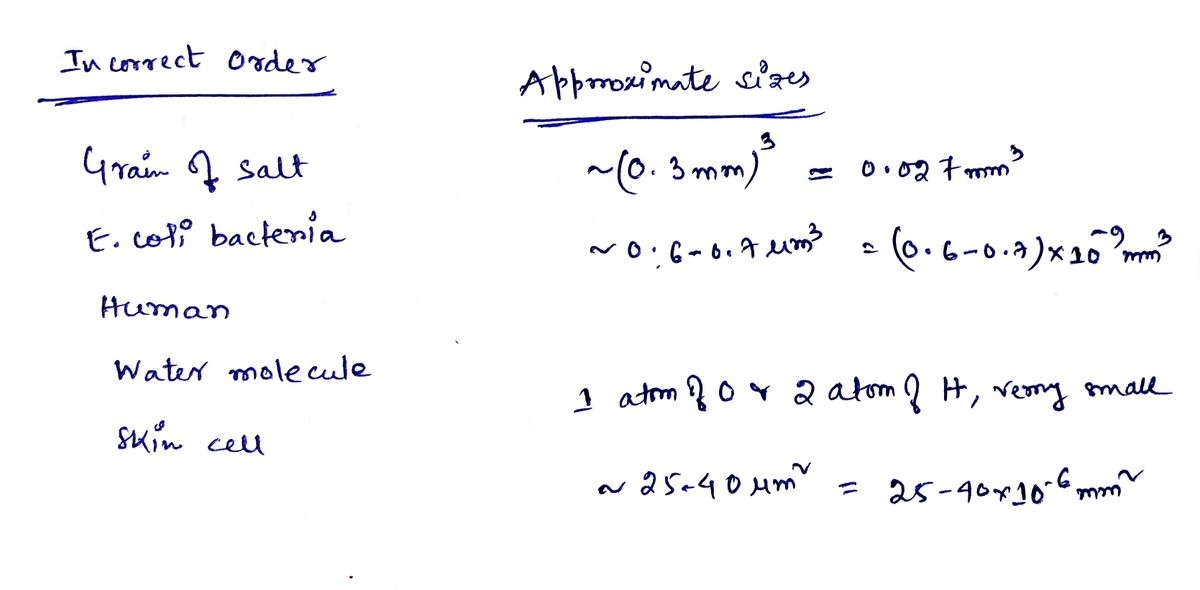These are some objects from the scale tool. Rewrite them in order from smallest to largest Incorrect Order Grain of salt E. coli bacteria Human Water Molecule Skin Cell Correct Order Smallest ↓ Largest
These are some objects from the scale tool. Rewrite them in order from smallest to largest Incorrect Order Grain of salt E. coli bacteria Human Water Molecule Skin Cell Correct Order Smallest ↓ Largest
Chemistry
10th Edition
ISBN:9781305957404
Author:Steven S. Zumdahl, Susan A. Zumdahl, Donald J. DeCoste
Publisher:Steven S. Zumdahl, Susan A. Zumdahl, Donald J. DeCoste
Chapter1: Chemical Foundations
Section: Chapter Questions
Problem 1RQ: Define and explain the differences between the following terms. a. law and theory b. theory and...
Related questions
Question
Order from smallest to greatest

Transcribed Image Text:# Understanding Scale: Ordering Objects from Smallest to Largest
In this activity, you are given a list of various objects. Your task is to arrange them in order from smallest to largest using the scale tool provided.
| Incorrect Order | Correct Order | Scale |
|-----------------|---------------|-------|
| Grain of salt | | |
| *E. coli* bacteria | | |
| Human | | |
| Water Molecule | | |
| Skin Cell | | |
### Task
- **Water Molecule**: Recognized as one of the smallest units, typically found at the molecular level.
- **E. coli Bacteria**: These are microscopic and larger than molecules but smaller than cells.
- **Skin Cell**: A basic structural unit of human tissue, larger than bacteria.
- **Grain of Salt**: Larger than a single cell, a grain of salt is visible to the naked eye.
- **Human**: The largest entity in this list, comprised of many cells and structures.
### Instructions
1. Identify the correct order of the objects.
2. Use the arrow indicators to determine the progression from smallest to largest.
3. Fill in the correct order on the table provided.
By engaging in this exercise, you'll develop a better understanding of the relative sizes of different objects and organisms in the natural world.
Expert Solution
Step 1
Here, we need to arrange the given substances(or particles) in ascending order in terms of their size.

Step by step
Solved in 2 steps with 2 images

Knowledge Booster
Learn more about
Need a deep-dive on the concept behind this application? Look no further. Learn more about this topic, chemistry and related others by exploring similar questions and additional content below.Recommended textbooks for you

Chemistry
Chemistry
ISBN:
9781305957404
Author:
Steven S. Zumdahl, Susan A. Zumdahl, Donald J. DeCoste
Publisher:
Cengage Learning

Chemistry
Chemistry
ISBN:
9781259911156
Author:
Raymond Chang Dr., Jason Overby Professor
Publisher:
McGraw-Hill Education

Principles of Instrumental Analysis
Chemistry
ISBN:
9781305577213
Author:
Douglas A. Skoog, F. James Holler, Stanley R. Crouch
Publisher:
Cengage Learning

Chemistry
Chemistry
ISBN:
9781305957404
Author:
Steven S. Zumdahl, Susan A. Zumdahl, Donald J. DeCoste
Publisher:
Cengage Learning

Chemistry
Chemistry
ISBN:
9781259911156
Author:
Raymond Chang Dr., Jason Overby Professor
Publisher:
McGraw-Hill Education

Principles of Instrumental Analysis
Chemistry
ISBN:
9781305577213
Author:
Douglas A. Skoog, F. James Holler, Stanley R. Crouch
Publisher:
Cengage Learning

Organic Chemistry
Chemistry
ISBN:
9780078021558
Author:
Janice Gorzynski Smith Dr.
Publisher:
McGraw-Hill Education

Chemistry: Principles and Reactions
Chemistry
ISBN:
9781305079373
Author:
William L. Masterton, Cecile N. Hurley
Publisher:
Cengage Learning

Elementary Principles of Chemical Processes, Bind…
Chemistry
ISBN:
9781118431221
Author:
Richard M. Felder, Ronald W. Rousseau, Lisa G. Bullard
Publisher:
WILEY